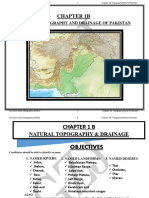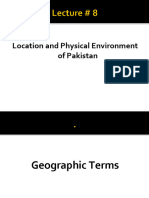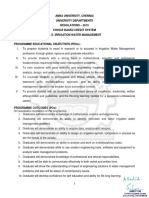SECTION-2 BAHRIA COLLEGE ANCHORAGE
GEOGRAPHY OF PAKISTAN STUDIES NOTES FOR CLASS IX
PAKISTAN Unit-4 The Natural Topography
and Vegetation of Pakistan
Additional MCQ’s
1. Himalayas cover _____ km from east to west? 2500
2. Most of central Himalayas generally located in _________. Kashmir
3. The Siwaliks hills have altitude between ________ meter. 600-1200
4. Hindu Kush Himalayan region is considered a part of the ________ Himalayan Mountain system. greater
5. K2, the second-highest mountain peak in the world, is also located in the __________. Karakoram
6. Waziristan Hills Located between Kurram and _________ River. Gomal
7. Balochistan has a ____ climate. Dry
8. The rainwater of the basins drains into the rivers and streams which either absorbed into the ground or forms
temporary lakes called _______. Hamuns
9. The largest Hamuns is found in ________ desert. Kharan
10. According to provincial Census report Blochistan 2017, the extraction of thirty-nine out of fifty mineral resources
present in the province generates an annual revenue close to _______ billion. 3.4
11. Pothwar plateau and Salt range are located between the river Indus and river ________. Jhelum
12. In Pothwar plateau farming depends on the _______. Natural rainfall
13. The Salt range is located ______ km from Islamabad. 160
14. A tract of land lying between two rivers is called __________. Doab
15. Thar desert is located in __________. Sind
� SECTION-2 BAHRIA COLLEGE ANCHORAGE
GEOGRAPHY OF PAKISTAN STUDIES NOTES FOR CLASS IX
PAKISTAN Unit-4 The Natural Topography
and Vegetation of Pakistan
Additional Short Q/A
1. What are the natural topographical regions of Pakistan?
The natural topography of Pakistan can be classified into six main regions.
1) The Northern Mountains and North-Western Mountains 4) Desert Areas
2) The Western Mountains 5) Pothwar Plateau and Salt Range
3) The Balochistan Plateau 6) The Indus Plain
2. Name the mountain ranges of North and North-Western Mountains?
This region includes following mountain ranges
✓ Himalayas
o Siwaliks, Lesser Himalayas, and Central Himalayas
✓ Hindu Kush
✓ Karakoram
3. Name the highest peaks of Himalayas, Hindu Kush and Karakoram Mountain ranges? Also write the altitude.
Mountain Rang Highest Peaks Altitude
Himalayas Nanga Parbat 8126 m
Hindu Kush Trich Mir 7690 m
Karakoram K2 8611 m
4. What are the characteristics of Karakoram Mountain Range?
The Karakoram Mountain range is characterized by narrow and deep valleys, such as Hunza, Shyok, and Baltoro; towering gorges, such
as the Nanga Parbat and Indus Gorges; and vast glaciers Such as Baltoro, Siachen, and Biafo Glaciers. K2, the second-highest mountain
peak in the world, is also located in the Karakoram. The precipitation at lower elevation is typically in the form of rain. In higher
elevations, precipitation is typically in the form of snow.
5. Write the significance of Northern Mountains?
✓ Major source of water
✓ The glaciers of the Northern mountains help to cool the planet.
✓ The home to a variety of unique and endangered wildlife species.
✓ Mountain peaks provide protection to Pakistan from cold winds of Siberia and Central Asia.
✓ The Northern Mountains offer a variety of economic opportunities. Such as tourism, agriculture, and forestry.
6. What is Doab?
Doab refers to a tract of land lying between two rives. Doab attract population because of the availability of flat land for the
construction, settlements and other industrial and business activities.
7. Write a short note on Indus Delta.
Indus delta is located in the south of Thatta. It is triangular or fan shape area with distributes coming out from the main river. It plays
a significant role in the ecology, economy and culture of Pakistan.
8. Write the important tropological features of Indus plains.
The tropological features of Indus plains are:
✓ Active Flood Plain: It is a narrow strip of land with rich alluvial deposits. Active flood plain is almost regularly flooded every year.
✓ Old Flood Plain: It is a high, flat area that was once flooded by a river. It is valuable for agricultural activities, food, flood control
and habitat.
✓ Alluvial Terraces: Alluvial Terraces or bars are flat and higher grounds. Typically made up of sand, silt, and clay and they are often
very fertile for forming
✓ Piedmont Plains or Alluvial Fans: These plains are formed by the river as soon as it comes out of mountains. These plains are
agriculturally productive.
✓ Tidal Delta: It is also called Indus delta. It is triangular or fan shape area with distributes coming out from the main river. It plays
a significant role in the ecology, economy and culture of Pakistan.
✓ Cuestas: It is important feature of lower Indus plain. These are limestone ridges gently sloping on one side and steep on the
other side. It provides firm foundation for the construction of barrages which are used for storage of water for irrigation and
fishing purposes.















































































